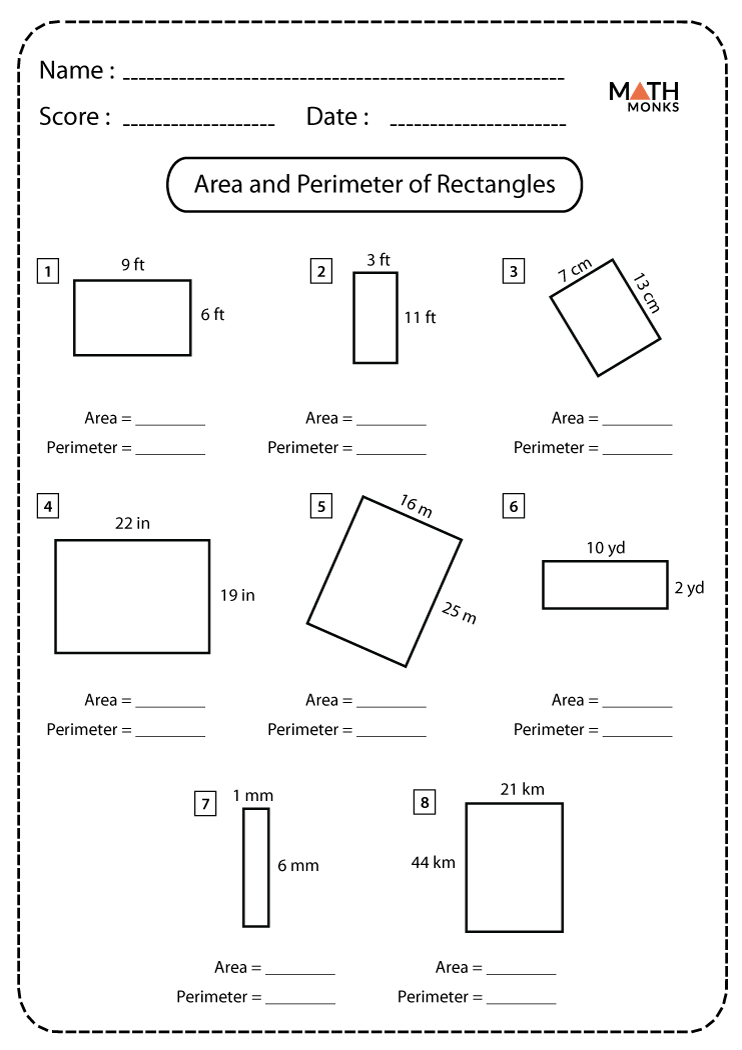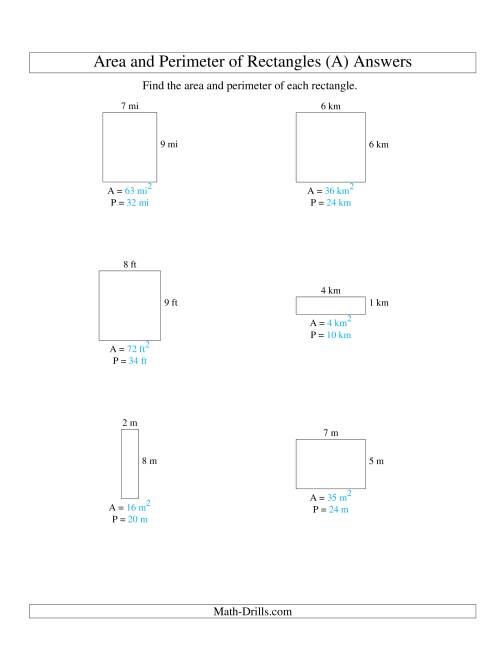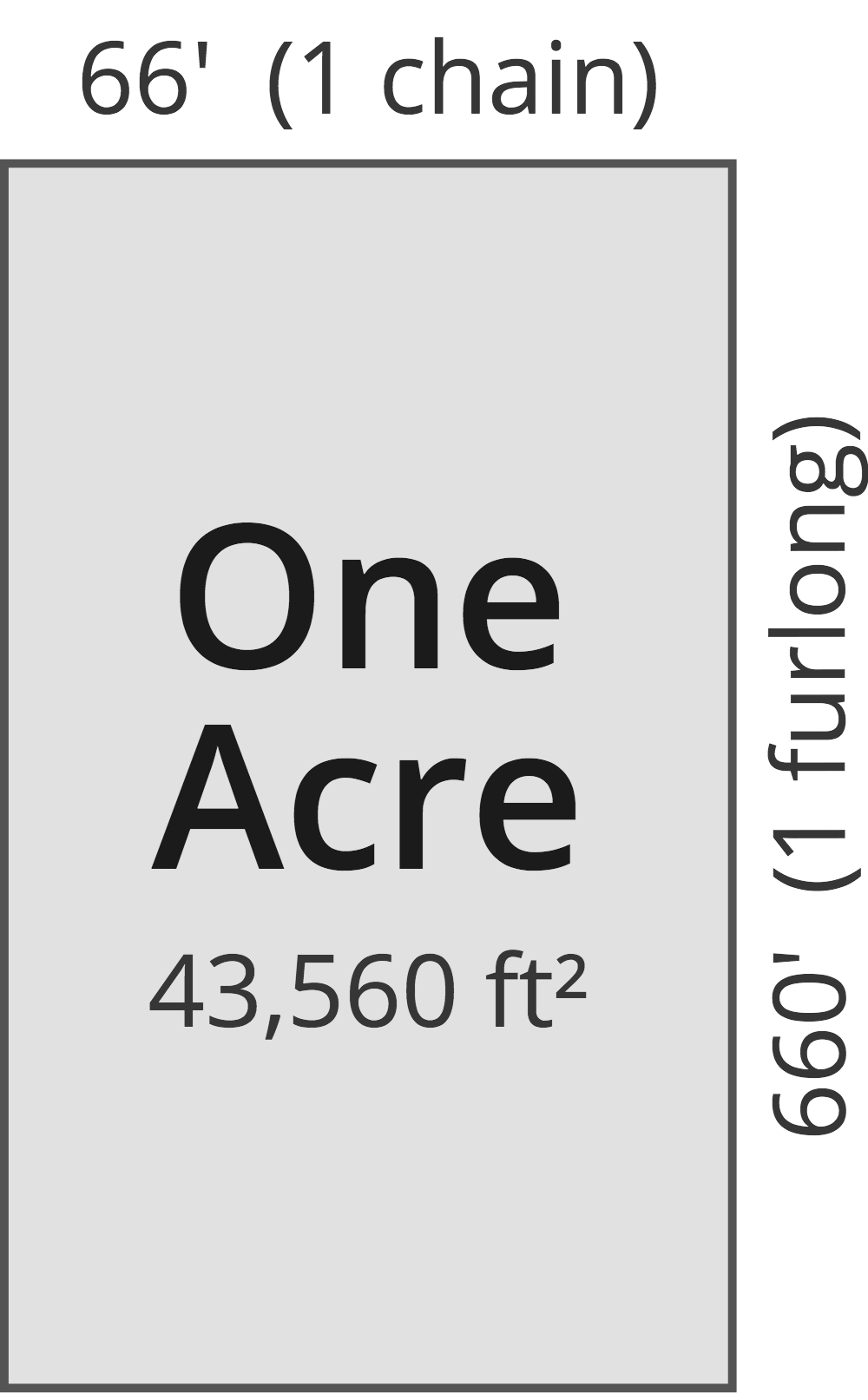Topic area and perimeter of rectangles worksheet: Discover comprehensive worksheets focused on the area and perimeter of rectangles. Perfect for students of all grades, these resources enhance understanding through practical problems and detailed explanations, making learning engaging and effective. Start improving your math skills today with our tailored worksheets!
Table of Content
Area and Perimeter of Rectangles Worksheet
Understanding the concepts of area and perimeter is essential in geometry, especially when dealing with rectangles. These worksheets are designed to help students grasp the calculations and applications of these concepts in a fun and engaging way.
Worksheet Overview
Introduction to Area and Perimeter
Area is the measure of the space inside a shape, while perimeter is the measure of the distance around a shape. For rectangles, these can be calculated using simple formulas.
Basic Formulas
The formulas for finding the area and perimeter of a rectangle are:
- Area (A): \( A = l \times w \), where \( l \) is the length and \( w \) is the width.
- Perimeter (P): \( P = 2l + 2w \) or \( P = 2(l + w) \).
Practice Problems
- A rectangle has a length of 5 cm and a width of 3 cm. Find its area and perimeter.
- Calculate the area and perimeter of a rectangle with a length of 7 m and a width of 4 m.
- A garden is 12 meters long and 8 meters wide. Determine the area and perimeter.
Advanced Applications
These worksheets also include advanced problems involving complex shapes that can be broken down into rectangles. Students will learn to apply their knowledge of area and perimeter to solve real-world problems.
Answer Keys
Answer keys are provided for all worksheets, allowing students to check their work and understand any mistakes they may have made.
Example Table
| Problem | Length | Width | Area | Perimeter |
| 1 | 5 cm | 3 cm | \( 5 \times 3 = 15 \, \text{cm}^2 \) | \( 2(5 + 3) = 16 \, \text{cm} \) |
| 2 | 7 m | 4 m | \( 7 \times 4 = 28 \, \text{m}^2 \) | \( 2(7 + 4) = 22 \, \text{m} \) |

READ MORE:
Introduction
Understanding the concepts of area and perimeter is fundamental in geometry, particularly when working with rectangles. These concepts not only help in solving mathematical problems but also have practical applications in various fields such as architecture, engineering, and everyday life.
The area of a rectangle is a measure of the space contained within its boundaries and is calculated by multiplying its length by its width. The formula is expressed as:
where l is the length and w is the width.
The perimeter of a rectangle, on the other hand, measures the distance around the rectangle and is calculated by adding the lengths of all four sides. The formula for the perimeter is:
where l is the length and w is the width.
Our worksheets are designed to help students from grade 2 through grade 8 master these concepts through a variety of problems that include counting squares, working with integers, decimals, and fractions, and solving word problems.
We offer printable worksheets and online interactive tools to cater to different learning preferences. Each worksheet comes with detailed instructions and examples to guide students through the process of calculating area and perimeter, ensuring a thorough understanding of the material.
By practicing with these worksheets, students will develop strong problem-solving skills and gain confidence in their ability to work with geometric shapes.
Understanding Area and Perimeter
To understand the concepts of area and perimeter of rectangles, it is essential to grasp their definitions and the mathematical formulas used to calculate them.
Area is the measure of the space inside a two-dimensional shape. For a rectangle, the area can be calculated by multiplying its length by its width.
Formula:
\( \text{Area} = \text{length} \times \text{width} \)
For example, if the length of a rectangle is 8 units and the width is 3 units, the area is:
\( \text{Area} = 8 \times 3 = 24 \, \text{square units} \)
Perimeter is the total distance around the edges of a two-dimensional shape. For a rectangle, the perimeter can be calculated by adding the lengths of all four sides.
Formula:
\( \text{Perimeter} = 2 \times (\text{length} + \text{width}) \)
For instance, if the length of a rectangle is 8 units and the width is 3 units, the perimeter is:
\( \text{Perimeter} = 2 \times (8 + 3) = 2 \times 11 = 22 \, \text{units} \)
Understanding these basic formulas allows students to solve various problems related to the area and perimeter of rectangles, such as those involving different units of measurement (integers, decimals, and fractions) and word problems that require applying these formulas in real-life scenarios.
Below is a summary of the steps to calculate area and perimeter:
- Identify the length and width of the rectangle.
- For area, multiply the length by the width using the formula \( \text{Area} = \text{length} \times \text{width} \).
- For perimeter, add the length and width, then multiply the sum by 2 using the formula \( \text{Perimeter} = 2 \times (\text{length} + \text{width}) \).
These fundamental concepts are crucial for solving problems and understanding more advanced geometric principles.
Formulas and Calculations
Calculating the area and perimeter of a rectangle is fundamental in geometry. Understanding these concepts is essential for solving various mathematical problems and real-world applications. Below are the key formulas and step-by-step methods for calculating the area and perimeter of rectangles.
-
Area of a Rectangle:
The area of a rectangle is the amount of space enclosed within its boundaries. The formula to calculate the area is:
\[ \text{Area} = \text{Length} \times \text{Width} \]
Where Length and Width are the lengths of the rectangle's sides.
- Example: If a rectangle has a length of 8 units and a width of 5 units, its area is:
\[ \text{Area} = 8 \times 5 = 40 \text{ square units} \]
-
Perimeter of a Rectangle:
The perimeter of a rectangle is the total distance around its edges. The formula to calculate the perimeter is:
\[ \text{Perimeter} = 2 \times (\text{Length} + \text{Width}) \]
Where Length and Width are the lengths of the rectangle's sides.
- Example: If a rectangle has a length of 8 units and a width of 5 units, its perimeter is:
\[ \text{Perimeter} = 2 \times (8 + 5) = 2 \times 13 = 26 \text{ units} \]
These formulas provide a simple yet powerful way to understand the properties of rectangles, making them invaluable for various calculations in geometry and everyday situations.
Worksheets by Grade Level
Our collection of worksheets for calculating the area and perimeter of rectangles is designed to meet the needs of students from Grade 2 through Grade 8. Each grade level features worksheets that are tailored to the appropriate skill level, ensuring that students can progressively build their understanding and abilities in geometry.
- Grade 2
- Introduction to area and perimeter concepts using simple shapes.
- Counting squares to find the area of rectangles.
- Basic perimeter calculations by adding side lengths.
- Grade 3
- Calculating area and perimeter using integer side lengths.
- Worksheets involving drawing and measuring rectangles on grids.
- Introduction to word problems involving area and perimeter.
- Grade 4
- More complex area and perimeter calculations.
- Problems involving rectangles with fractional side lengths.
- Application of area and perimeter in real-world contexts.
- Grade 5
- Advanced problems involving larger integers and decimals.
- Mixed practice worksheets combining different geometric shapes.
- Use of unit conversions in area and perimeter calculations.
- Grade 6
- Challenging problems involving composite shapes.
- Finding missing side lengths given area or perimeter.
- Application of formulas in varied contexts, including word problems.
- Grade 7
- Complex problems involving algebraic expressions.
- Detailed word problems requiring multiple steps to solve.
- Exploration of rectilinear figures and irregular shapes.
- Grade 8
- Advanced applications involving real-life scenarios.
- Integration with other math topics such as algebra and data analysis.
- Projects and investigations requiring in-depth understanding of area and perimeter.

Types of Problems
Understanding the different types of problems you might encounter when working with the area and perimeter of rectangles is crucial for mastering these concepts. Below are various types of problems, categorized to help you practice and enhance your skills step by step:
- Counting Squares:
These problems involve calculating the area and perimeter by counting the number of unit squares within a rectangle. This method is often used in introductory exercises to build a foundational understanding of the concepts.
- Integers:
Problems in this category use whole numbers for the dimensions of the rectangles. You'll practice applying the area formula \( \text{Area} = \text{length} \times \text{width} \) and the perimeter formula \( \text{Perimeter} = 2 \times (\text{length} + \text{width}) \) with integer values.
- Decimals:
These problems introduce decimal values for the dimensions, requiring more precision in calculation. You'll apply the same formulas for area and perimeter but must be careful with decimal multiplication and addition.
- Fractions:
Here, the dimensions of the rectangles are given as fractions. You'll practice multiplying and adding fractions to find the area and perimeter. This enhances your understanding of fractions in a geometric context.
- Word Problems:
These problems present real-life scenarios where you need to calculate the area and perimeter of rectangles. Word problems often combine multiple steps and require careful reading and problem-solving skills.
- Example: "The length of a rectangular garden is 5 meters more than its width. If the width is 3 meters, find the area and perimeter of the garden."
- Example: "A rectangular pool is twice as long as it is wide. If the width is 4 meters, calculate the area and perimeter of the pool."
Practicing a variety of problems will help you become proficient in calculating area and perimeter under different conditions and prepare you for more complex mathematical challenges.
Customizable Worksheets
Customizable worksheets provide an excellent resource for teachers and parents to tailor learning experiences to individual student needs. These worksheets cover various aspects of calculating the area and perimeter of rectangles, ensuring that students grasp the concepts thoroughly.
- Select Difficulty Level:
- Basic: Suitable for younger students or beginners, focusing on simple rectangles with integer side lengths.
- Intermediate: Introduces decimals and fractions, challenging students to apply their knowledge in more complex scenarios.
- Advanced: Combines different geometric shapes and requires converting units, suitable for older or more advanced students.
- Choose Problem Types:
- Counting Squares: Helps students understand the concept of area by counting unit squares within a rectangle.
- Formula Application: Practice using the area formula \( A = l \times w \) and perimeter formula \( P = 2(l + w) \) for various problems.
- Mixed Operations: Combines addition, subtraction, multiplication, and division within the context of area and perimeter problems.
- Word Problems: Real-world scenarios where students need to determine the area or perimeter of given rectangles.
- Customizable Parameters:
- Length and Width: Set the range of lengths and widths for the rectangles to match the students' proficiency level.
- Measurement Units: Choose between customary units (inches, feet) and metric units (centimeters, meters) based on the curriculum requirements.
- Number of Problems: Specify the number of problems per worksheet to control the length and depth of the practice session.
These customizable worksheets can be generated and printed, ensuring a unique and engaging learning experience every time. The flexibility in customization allows educators to adapt the material to meet the diverse learning needs of their students, promoting better understanding and mastery of the concepts of area and perimeter.
Interactive Tools
Interactive tools are an excellent way to engage students in learning about the area and perimeter of rectangles. These tools provide a hands-on approach to understanding mathematical concepts through visualization and manipulation. Here are some recommended interactive tools:
-
Live Worksheets:
Live Worksheets offer a range of interactive worksheets where students can practice calculating the area and perimeter of rectangles. These worksheets provide immediate feedback, allowing students to learn and correct their mistakes in real-time.
Example:
-
PhET Interactive Simulations:
The PhET Interactive Simulations project at the University of Colorado Boulder provides a simulation called "Area Builder," where students can explore the concepts of area and perimeter by creating shapes and observing the effects on measurements. This tool is great for visual and interactive learning.
Example:
-
Toy Theater's Area Perimeter Explorer:
This interactive game allows students to create rectangles and other shapes by dragging colored blocks onto a grid. The tool calculates and displays the perimeter and area, helping students understand these concepts through experimentation and play.
Example:
These tools provide students with a dynamic and engaging way to learn about the area and perimeter, making abstract concepts more concrete and understandable.
Additional Resources
Enhance your understanding and practice of area and perimeter of rectangles with the following additional resources:
- Printable Worksheets: Access a variety of printable worksheets that provide step-by-step problems for calculating area and perimeter of rectangles. These worksheets cater to different grade levels and difficulty settings.
- Online Practice: Engage with interactive worksheets and online tools that offer immediate feedback. These resources are designed to help students practice calculations and improve their skills in a dynamic environment.
- Answer Keys: Utilize answer keys to check your work and ensure accuracy. These keys provide detailed solutions and explanations for each problem, helping you understand the steps involved in the calculations.
- Geometry Worksheets: Explore additional worksheets that cover broader topics in geometry, including various shapes and their properties. These resources provide a comprehensive approach to learning geometry.
- Mathway Calculator: Use the Mathway calculator for quick and accurate solutions to area and perimeter problems. This tool is ideal for checking work and exploring different problem-solving methods.
These resources are designed to provide comprehensive support and practice opportunities, ensuring a thorough understanding of area and perimeter calculations.

Feedback and Support
Your feedback is invaluable to us. It helps us improve our resources and provide the best possible learning experience. Here are several ways you can provide feedback and seek support:
- Submit Feedback: Use our online feedback form to share your thoughts and suggestions. Your input on worksheet content, clarity, and overall usability is highly appreciated.
- Report Issues: If you encounter any problems with our worksheets or online tools, please report them through our issue tracker. This helps us quickly address and resolve any technical difficulties.
- FAQs: Check our Frequently Asked Questions page for answers to common queries about the worksheets, calculations, and interactive tools.
- Contact Support: For more personalized assistance, contact our support team via email or phone. We aim to respond to all inquiries within 24 hours.
- Community Forum: Join our online community forum to discuss math problems, share tips, and collaborate with other educators and learners.
- Updates and News: Subscribe to our newsletter to receive updates on new worksheets, tools, and educational resources.
We are committed to providing high-quality educational materials and appreciate your help in making our worksheets the best they can be.
Cách tìm Diện tích và Chu vi của Hình chữ nhật
READ MORE:
Cách Tìm Chu Vi của Hình Chữ Nhật | Toán với Thầy J












